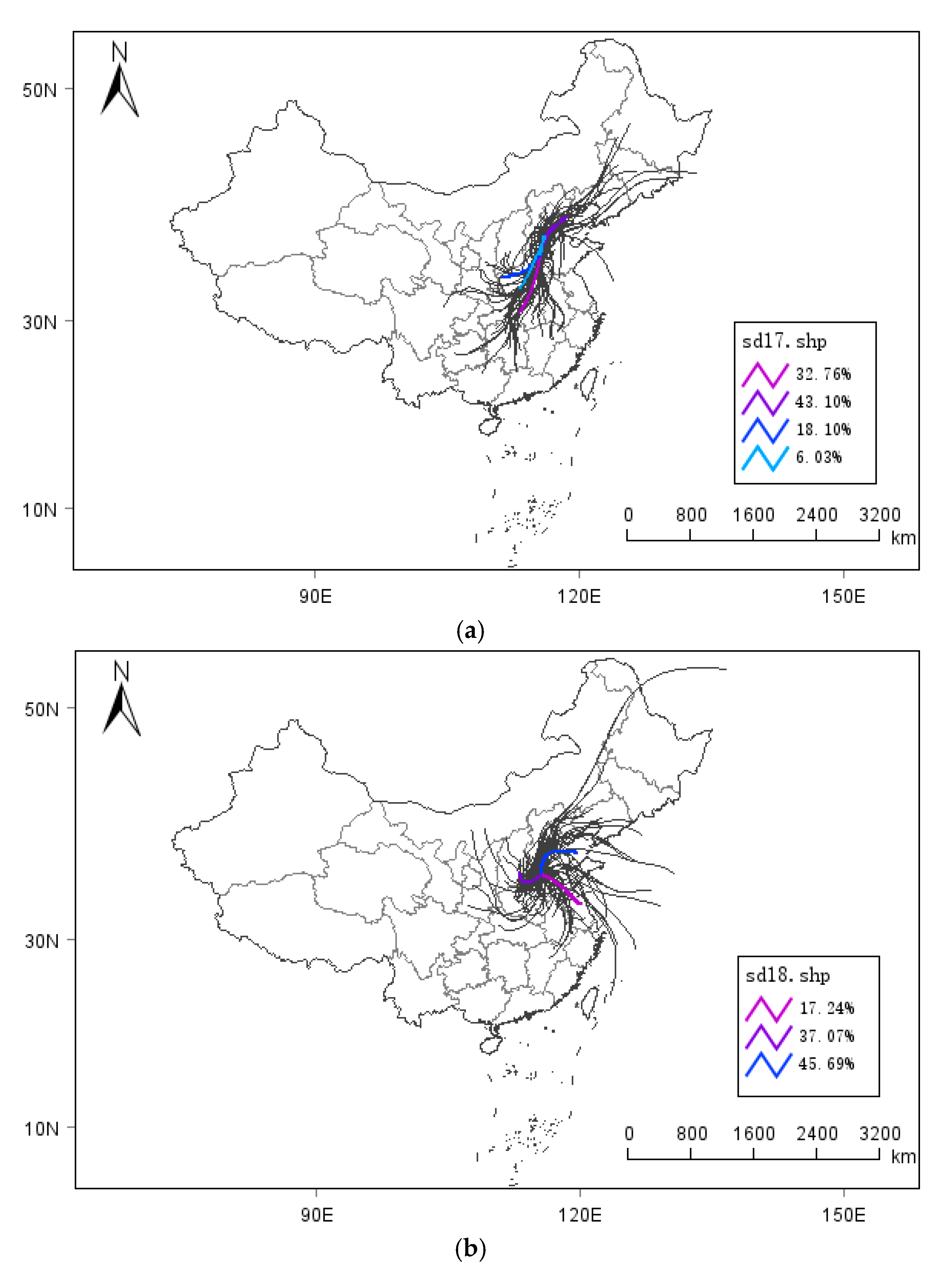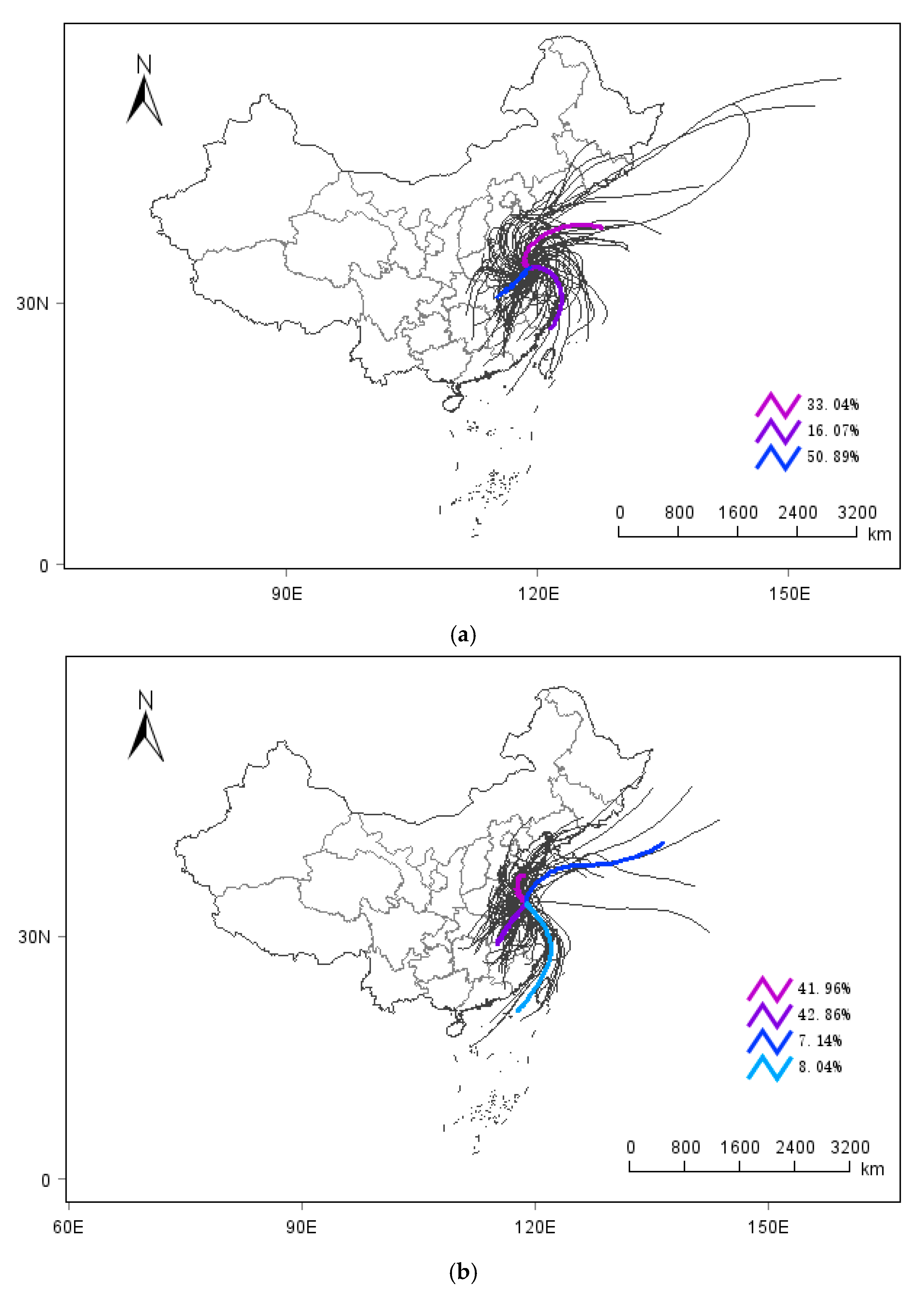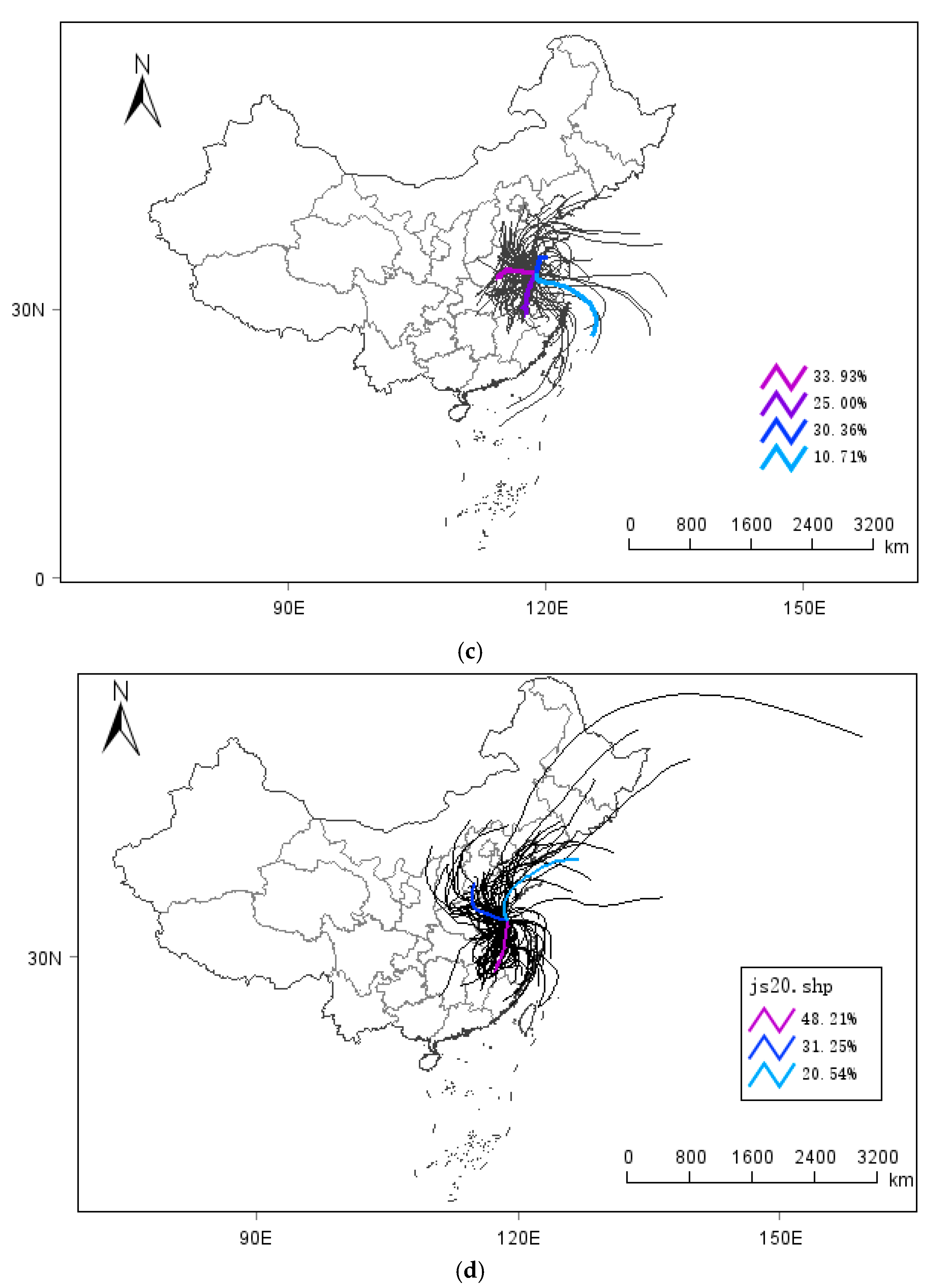Transmission Route of Airborne Fungal Spores for Cucumber Downy Mildew
Abstract
:1. Introduction
2. Materials and Methods
2.1. Experimental Data
2.2. Calculation Method of Airflow Trajectory
3. Results and Analysis
3.1. Cluster Analysis Results
3.2. Trajectory Simulation Results and Analysis
4. Conclusions
Author Contributions
Funding
Data Availability Statement
Acknowledgments
Conflicts of Interest
References
- Yan, H.F.; Acquah, S.J.; Zhang, J.Y.; Wang, G.Q.; Zhang, C.; Darko, R.O. Overview of modelling techniques for greenhouse microclimate environment and evapotranspiration. Int. J. Agric. Biol. Eng. 2021, 14, 1–8. [Google Scholar] [CrossRef]
- Rasool, G.; Guo, X.P.; Wang, Z.C.; Ali, M.U.; Chen, S.; Zhang, S.X.; Wu, Q.; Ullah, M.S. Coupling fertigation and buried straw layer improves fertilizer use efficiency, fruit yield, and quality of greenhouse tomato. Agric. Water Manag. 2020, 239, 106239. [Google Scholar] [CrossRef]
- Yan, H.F.; Zhang, C.; Gerrits, M.C.; Acquah, S.J.; Zhang, H.N.; Wu, H.M.; Zhao, B.S.; Huang, S.; Fu, H.W. Parametrization of aerodynamic and canopy resistances for modeling evapotranspiration of greenhouse cucumber. Agric. For. Meteorol. 2018, 262, 370–378. [Google Scholar] [CrossRef]
- Zhang, C.; Li, X.Y.; Yan, H.F.; Ullah, I.; Zuo, Z.Y.; Li, L.L.; Yu, J.J. Effects of irrigation quantity and biochar on soil physical properties, growth characteristics, yield and quality of greenhouse tomato. Agric. Water Manag. 2020, 241, 106263. [Google Scholar] [CrossRef]
- Rasool, G.; Guo, X.P.; Wang, Z.C.; Chen, S.; Hamoud, Y.A.; Javed, Q. Response of Fertigation Under Buried Straw Layer on Growth, Yield, and Water-fertilizer Productivity of Chinese Cabbage Under Greenhouse Conditions. Commun. Soil Sci. Plant Anal. 2019, 50, 1030–1043. [Google Scholar] [CrossRef]
- Xu, Y.H.; Ma, Y.; Luz, C.M.; Angel, S.M.M.; Wang, Q.J. Compost biochemical quality mediates nitrogen leaching loss in a greenhouse soil under vegetable cultivation. Geoderma 2020, 358, 113984. [Google Scholar] [CrossRef]
- Yan, H.F.; Acquah, S.J.; Zhang, C.; Wang, G.Q.; Huang, S.; Zhang, H.N.; Zhao, B.S.; Wu, H.M. Energy partitioning of greenhouse cucumber based on the application of Penman-Monteith and Bulk Transfer models. Agric. Water Manag. 2019, 217, 201–211. [Google Scholar] [CrossRef]
- Mao, H.P.; Wang, Y.F.; Yang, N.; Liu, Y.; Zhang, X.D. Effects of nutrient solution irrigation quantity and powdery mildew infection on the growth and physiological parameters of greenhouse cucumbers. Int. J. Agric. Biol. Eng. 2022, 15, 68–74. [Google Scholar] [CrossRef]
- Rasool, G.; Guo, X.P.; Wang, Z.C.; Hassan, M.; Aleem, M.; Javed, Q.; Chen, S. Effect of Buried Straw Layer Coupled with Fertigation on Florescence and Yield Parameters of Chinese Cabbage Under Greenhouse Environment. J. Soil Sci. Plant Nutr. 2020, 20, 598–609. [Google Scholar] [CrossRef]
- Huang, S.; Yan, H.F.; Zhang, C.; Wang, G.Q.; Acquah, S.J.; Yu, J.J.; Li, L.L.; Mam, J.M.; Darko, R.O. Modeling evapotranspiration for cucumber plants based on the Shuttleworth-Wallace model in a Venlo-type greenhouse. Agric. Water Manag. 2020, 228, 105861. [Google Scholar] [CrossRef]
- Gokulnath, B.V.; Devi, U.G. A Survey on Plant Disease Prediction using Machine Learning and Deep Learning Techniques. Intel. Artif.-Iberoamerical J. Artif. Intell. 2020, 23, 136–154. [Google Scholar] [CrossRef]
- Zhu, W.D.; Sun, J.; Wang, S.M.; Shen, J.F.; Yang, K.F.; Zhou, X. Identifying Field Crop Diseases Using Transformer-Embedded Convolutional Neural Network. Agriculture 2022, 12, 1083. [Google Scholar] [CrossRef]
- Berdugo, C.A.; Zito, R.; Paulus, S.; Mahlein, A.-K. Fusion of sensor data for the detection and differentiation of plant diseases in cucumber. Plant Pathol. 2014, 63, 1344–1356. [Google Scholar] [CrossRef]
- Granke, L.L.; Morrice, J.J.; Hausbeck, M.K. Relationships between airborne pseudoperonospora cubensis sporangia environmental conditions, and cucumber downy mildew severity. Plant Dis. 2014, 98, 674–681. [Google Scholar] [CrossRef]
- Neufeld, K.N.; Keinath, A.P.; Ojiambo, P.S. A model to predict the risk of infection of cucumber by Pseudoperonospora cubensis. Microb. Risk Anal. 2017, 6, 21–30. [Google Scholar] [CrossRef]
- Tao, Z.N.; Malvick, D.; Claybrooke, R.; Floyd, C.; Bernacchi, C.J.; Spoden, G.; Kurle, J.; Gay, D.; Bowersox, V.; Krupa, S. Predicting the risk of soybean rust in Minnesota based on an integrated atmospheric model. Int. J. Biometeorol. 2009, 53, 509–521. [Google Scholar] [CrossRef]
- Olsen, Y.; Begovic, T.; Skjoth, C.A.; Rasmussen, K.; Gosewinkel, U.; Hertel, O.; Sigsgaard, T. Grain harvesting as a local source of Cladosporium spp. in Denmark. Aerobiologia 2019, 35, 373–378. [Google Scholar] [CrossRef]
- Pan, Z.; Yang, X.B.; Pivonia, S.; Xue, L.; Pasken, R.; Roads, J. Long-term prediction of soybean rust entry into the continental United States. Plant Dis. 2006, 90, 840–846. [Google Scholar] [CrossRef]
- Xu, Y.F.; Zhang, X.L.; Sun, X.J.; Wang, J.Z.; Liu, J.Z.; Li, Z.G.; Guo, Q.; Li, P.P. Tensile mechanical properties of greenhouse cucumber cane. Int. J. Agric. Biol. Eng. 2016, 9, 1–8. [Google Scholar] [CrossRef]
- Abubaker, B.A.; Yan, H.F.; Hong, L.; You, W.Y.; Elshaikh, N.A.; Hussei, G.; Pandab, S.; Hassan, S. Enhancement of Depleted Loam Soil as Well as Cucumber Productivity Utilizing Biochar Under Water Stress. Commun. Soil Sci. Plant Anal. 2019, 50, 49–64. [Google Scholar] [CrossRef]
- Xu, Y.F.; Zhang, X.L.; Wu, S.; Chen, C.; Wang, J.Z.; Yuan, S.Q.; Chen, B.; Li, P.P.; Xu, R.J. Numerical simulation of particle motion at cucumber straw grinding process based on EDEM. Int. J. Agric. Biol. Eng. 2020, 13, 227–235. [Google Scholar] [CrossRef]
- Ali, A.B.; Elshaikh, N.A.; Hussien, G.; Abdallah, F.E.; Hassan, S. Biochar Addition For Enhanced Cucumber Fruit Quality Under Deficit Irrigation. Biosci. J. 2020, 36, 1930–1937. [Google Scholar] [CrossRef]
- Hsiao, T.C.; Chen, W.N.; Ye, W.C.; Lin, N.H.; Tsay, S.C.; Lin, T.H.; Lee, C.T.; Chuang, M.T.; Pantina, P.; Wang, S.H. Aerosol optical properties at the Lulin Atmospheric Background Station in Taiwan and the influences of long-range transport of air pollutants. Atmos. Environ. 2017, 150, 366–378. [Google Scholar] [CrossRef]
- Putero, D.; Cristofanelli, P.; Laj, P.; Marinoni, A.; Villani, P.; Broquet, A.; Alborghetti, M.; Bonafe, U.; Calzolari, F.; Duchi, R.; et al. New atmospheric composition observations in the Karakorum region: Influence of local emissions and large-scale circulation during a summer field campaign. Atmos. Environ. 2014, 97, 75–82. [Google Scholar] [CrossRef]
- Tahir, H.E.; Zou, X.B.; Huang, X.W.; Shi, J.Y.; Mariod, A.A. Discrimination of honeys using colorimetric sensor arrays, sensory analysis and gas chromatography techniques. Food Chem. 2016, 206, 37–43. [Google Scholar] [CrossRef]
- Wu, X.H.; Zhou, J.; Wu, B.; Sun, J.; Dai, C.X. Identification of tea varieties by mid-infrared diffuse reflectance spectroscopy coupled with a possibilistic fuzzy c-means clustering with a fuzzy covariance matrix. J. Food Process Eng. 2019, 42, e13298. [Google Scholar] [CrossRef]
- Wang, Y.F.; Yang, N.; Ma, G.X.; Taha, M.F.; Mao, H.P.; Zhang, X.D.; Shi, Q. Detection of spores using polarization image features and BP neural network. Int. J. Agric. Biol. Eng. 2024, 17, 213–221. [Google Scholar] [CrossRef]
- Wang, Y.F.; Shi, Q.; Ren, S.J.; Li, T.Z.; Yang, N.; Zhang, X.D.; Ma, G.X.; Taha, M.F.; Mao, H.P. Application of a spore detection system based on diffraction imaging to tomato gray mold. Int. J. Agric. Biol. Eng. 2024, 17, 212–217. [Google Scholar] [CrossRef]
- Zhou, H.X.; Fu, H.J.; Wu, X.H.; Wu, B.; Dai, C.X. Discrimination of tea varieties based on FTIR spectroscopy and an adaptive improved possibilistic c-means clustering. J. Food Process. Preserv. 2020, 44, e14795. [Google Scholar] [CrossRef]
- Wu, X.H.; Zhou, H.X.; Wu, B.; Fu, H.J. Determination of apple varieties by near infrared reflectance spectroscopy coupled with improved possibilistic Gath-Geva clustering algorithm. J. Food Process. Preserv. 2020, 44, e14561. [Google Scholar] [CrossRef]
- Li, Q.L.; Wu, X.H.; Zheng, J.; Wu, B.; Jian, H.; Sun, C.Z.; Tang, Y.B. Determination of Pork Meat Storage Time Using Near-Infrared Spectroscopy Combined with Fuzzy Clustering Algorithms. Foods 2022, 11, 2101. [Google Scholar] [CrossRef] [PubMed]
- Hu, C.P.; Xu, H.J.; Fu, Z.M.; Wu, B.; Zhang, R.; Zhi, C.H. Non-destructive Identification of the geographical origin of red jujube by near-infrared spectroscopy and fuzzy clustering methods. Int. J. Food Prop. 2023, 26, 3275–3290. [Google Scholar] [CrossRef]
- He, L.L.; Chen, R.; Lan, F.; Yang, H.; Gao, R.C.; Jin, W.A. Analysis of VOCs in Lueyang Black Chicken Breast Meat during the Steaming Process with GC-IMS and Stoichiometry. J. Food Qual. 2024, 2024, 6663167. [Google Scholar] [CrossRef]







| Simulated Source Point | Longitude and Latitude | Simulation Period | Simulated Height/m |
|---|---|---|---|
| Xinxian County, Shandong Province | 36.18° N, 115.61° E | From 1 October to 30 October | 100 |
| Pingquan City, Hebei Province | 41.11° N, 118.75° E | From 1 October to 30 October | 1000 |
| Huaiyin District, Huaian, Jiangsu | 33.58° N, 118.86° E | From 1 November to 30 November | 100 |
Disclaimer/Publisher’s Note: The statements, opinions and data contained in all publications are solely those of the individual author(s) and contributor(s) and not of MDPI and/or the editor(s). MDPI and/or the editor(s) disclaim responsibility for any injury to people or property resulting from any ideas, methods, instructions or products referred to in the content. |
© 2025 by the authors. Licensee MDPI, Basel, Switzerland. This article is an open access article distributed under the terms and conditions of the Creative Commons Attribution (CC BY) license (https://creativecommons.org/licenses/by/4.0/).
Share and Cite
Wang, Y.; Shi, Q.; Xu, G.; Yang, N.; Chen, T.; Taha, M.F.; Mao, H. Transmission Route of Airborne Fungal Spores for Cucumber Downy Mildew. Horticulturae 2025, 11, 336. https://doi.org/10.3390/horticulturae11030336
Wang Y, Shi Q, Xu G, Yang N, Chen T, Taha MF, Mao H. Transmission Route of Airborne Fungal Spores for Cucumber Downy Mildew. Horticulturae. 2025; 11(3):336. https://doi.org/10.3390/horticulturae11030336
Chicago/Turabian StyleWang, Yafei, Qiang Shi, Guilin Xu, Ning Yang, Tianhua Chen, Mohamed Farag Taha, and Hanping Mao. 2025. "Transmission Route of Airborne Fungal Spores for Cucumber Downy Mildew" Horticulturae 11, no. 3: 336. https://doi.org/10.3390/horticulturae11030336
APA StyleWang, Y., Shi, Q., Xu, G., Yang, N., Chen, T., Taha, M. F., & Mao, H. (2025). Transmission Route of Airborne Fungal Spores for Cucumber Downy Mildew. Horticulturae, 11(3), 336. https://doi.org/10.3390/horticulturae11030336











